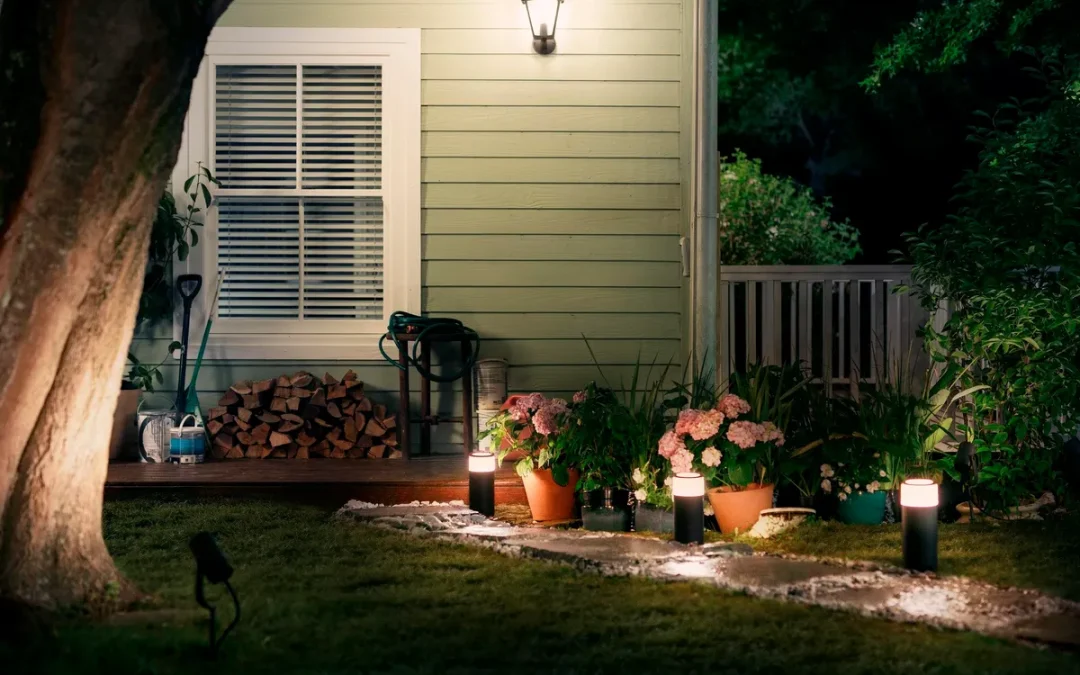For a stylish, safe space that suits your needs, mix and match lanterns, string lights, and other types of outdoor lighting.
1.Security Lighting
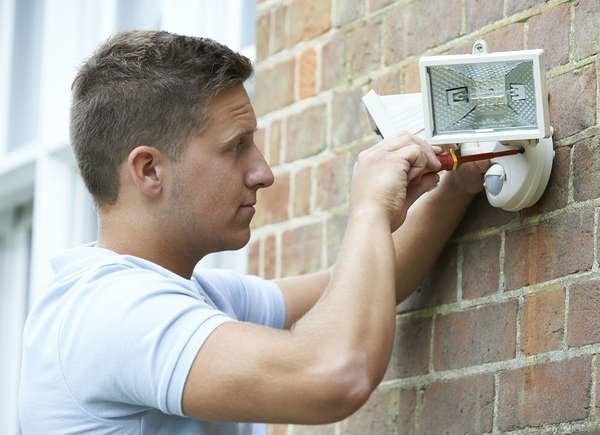
Security lighting, generally the brightest kind of yard lights, is safety lighting to illuminate large areas and scare off would-be burglars or destructive animals. Powered by standard, 120-Volt current, this lighting is installed high spots such as the eaves or above a garage to cast wide beams of light down onto main walkways or the backyard fence entrance.
Your best bet for security is motion-sensing floodlights that mount to the surface of exterior siding or walls and contain two- or three-bulb housing units that go on only when built-in sensors detect movement in the area. Their intense light exposes prowlers and may fool them into thinking you’re home and on alert even if you’re not.
2.Path Lighting

Path lighting is soft to moderately bright safety and landscape lighting designed to help you navigate walkways while attractively highlighting them. Install it on the ground along both sides of main walkways from the back door to your fence door, along stepping stones from the main walkway to a backyard feature like a fountain, and/or around flower beds to emphasize their contours.
Path lighting is often available in low-voltage (12- to 15-V) and solar LED options consisting of a decorative bulb housing unit attached to a short stake you drive into the ground. If you choose low-voltage path lights, you’ll need to use a transformer to reduce the 120-volt house current to 12 volts; energy-saving solar versions, meanwhile, require no extra wires. Even if your walkways are shaded, these lights will stay bright for several hours after dusk, thanks to a solar rechargeable battery or remote solar panel you station somewhere else in the yard that gets direct sun.
3.String Lighting

String lighting is soft, low-voltage accent lighting used to evoke a warm, intimate ambiance that’s especially desirable for entertaining. Hang outdoor string lights wherever the activity is, be it on the eaves of the home to brighten an outdoor kitchen or from the posts of a pavilion or gazebo to illuminate patio furniture.
Look for waterproof, rechargeable, traditional battery-powered or solar string lights (which usually come with a remote solar panel), preferably those with long-lasting LED bulbs. Such lights avoid the need for running extension cords across the yard, enable lighting in far corners of the yard without electrical outlets, and ensure that lights stay on safely even if spattered with rain.
4.Outdoor Wall Lighting
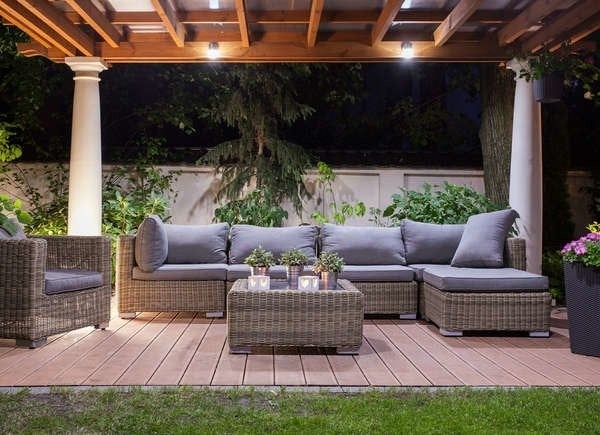
Outdoor wall lighting is a low-voltage, moderately bright form of safety and accent lighting used chiefly to illuminate and improve navigation in small recessed areas of the yard where shadows lurk. You can mount them on any vertical surface, such as along the interior of your pergola; above stairways; and around sunken seating areas, pools, and other low-lying spots.
Wall sconces with an open-bottomed design (i.e., the bottom of the bulb housing is uncovered) are the best options because they cast the maximum amount of light down onto recessed areas. If you have scarce space on exterior walls, consider semi-flush-mount sconces (i.e., the light is attached to a narrow arm that mounts to a plate on the wall) instead of flush-mount sconces with the whole fixture up against the wall.
5.Lanterns
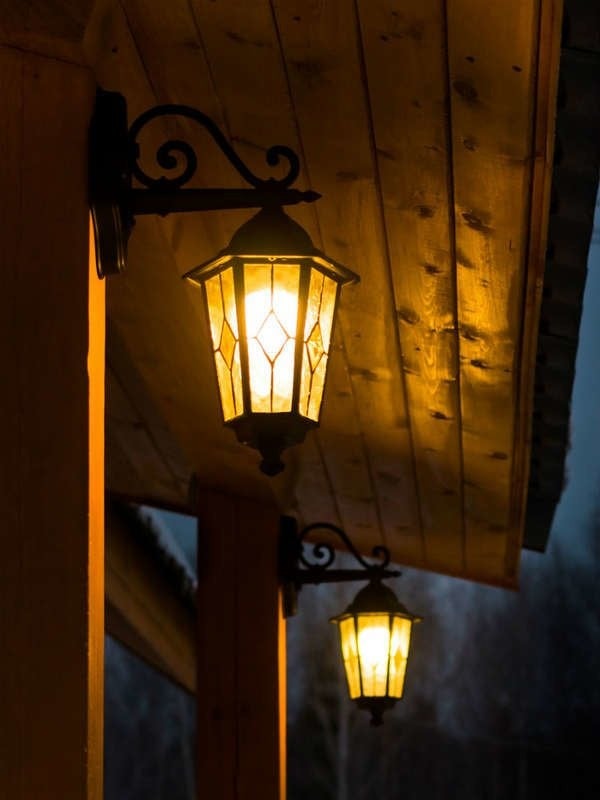
Lanterns offer soft, low-voltage accent lighting for a small expanse of an outdoor wall to play up architectural details or decor. They’re often installed in the vicinity of the back door to highlight a transom window, arch, or ornate wreath atop it. Most lanterns are semi-flush mount, consisting of a glass-and-metal exterior attached to an arm affixed to a plate on the wall. However, battery-powered tabletop lanterns bring that same visual interest to eye level while softly illuminating elements that you might reach for when outside entertaining: bowls of snacks, beverages, board games, and more. Choose lanterns with a translucent as opposed to a clear glass covering to provide diffuse, glare-free nighttime lighting that doesn’t distract from other backyard light fixtures.
6.Security Lighting
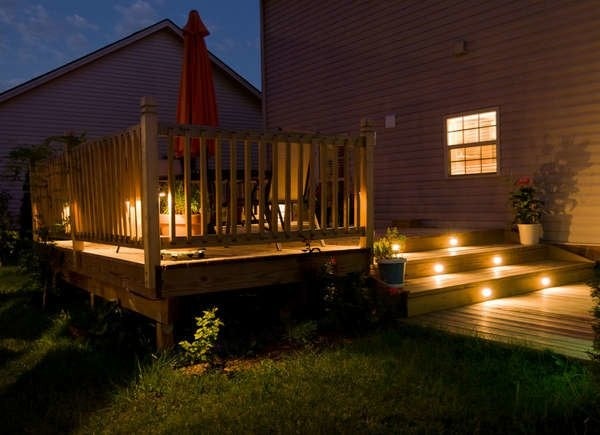
Deck lighting is standard-voltage, moderate- to high-intensity lighting designed to help folks get up, down, and across the deck by night, avoiding tripping hazards and visual clutter, and also accentuate nearby garden features.
It’s installed as a series of LED lights recessed into grooves in the surface, so that you can safely walk over them, never even feeling them underfoot. Deck lights also belong around the perimeter of the deck surface, in between the individual steps of stairs, and/or along deck stair railings.
7.Spot Lighting

Also known as “up-lighting” or simply landscape lighting, spot lighting is standard-voltage landscaping lighting used to shine narrow, moderate- to high-intensity beams upwards, usually to showcase a plant or ornamental feature. You might install it at or above ground level below tall trees or a lawn ornament to make them look more statuesque.
To light taller objects, such as trees, opt for bullet-shaped lights on a base you drive into the ground with a stake. Bullet lights have an adjustable head that sits above ground and casts bright pins of light over longer distances at an angle of your choice. For shorter features, such as shrubs, try well lights, round lights that are pushed into the ground to cast light upwards over shorter distances. Because they’re hidden in the ground, they let small garden features take center stage.
By: https://www.bobvila.com/articles/backyard-lighting-ideas/
